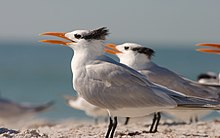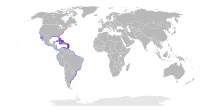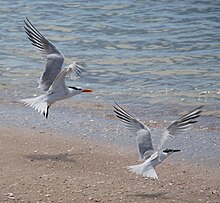Royal tern
| Royal tern | |
|---|---|

| |
| Winter plumage | |
| Scientific classification | |
| Domain: | Eukaryota |
| Kingdom: | Animalia |
| Phylum: | Chordata |
| Class: | Aves |
| Order: | Charadriiformes |
| Family: | Laridae |
| Genus: | Thalasseus |
| Species: | T. maximus
|
| Binomial name | |
| Thalasseus maximus (Boddaert, 1783)
| |

| |
| Synonyms | |
|
Sterna maxima | |
The royal tern (Thalasseus maximus) is a tern in the family Laridae. The species is endemic to the Americas, though vagrants have been identified in Europe.[2]
Taxonomy
[edit]The royal tern was described by the French polymath Georges-Louis Leclerc, Comte de Buffon in 1781 in his Histoire Naturelle des Oiseaux from a specimen collected in Cayenne, French Guiana.[3] The bird was also illustrated in a hand-colored plate engraved by François-Nicolas Martinet in the Planches Enluminées D'Histoire Naturelle which was produced under the supervision of Edme-Louis Daubenton to accompany Buffon's text.[4] Neither the plate caption nor Buffon's description included a scientific name but in 1783 the Dutch naturalist Pieter Boddaert coined the binomial name Sterna maxima in his catalogue of the Planches Enluminées.[5] The royal tern is now placed in the genus Thalasseus that was erected by the German zoologist Friedrich Boie in 1822.[6][7]
The generic name is derived from the Ancient Greek θάλασσα (thálassa) meaning "sea". The specific epithet maximus is Latin for "greatest".[8]
The royal tern belongs to the class Aves and the order Charadriiformes. Charadriiformes includes seabirds and shorebirds of small to medium-large size. Within Charadriiformes, it is placed in the family Laridae, subfamily Sterninae, because of its white plumage, a black cap on its head, long bill, webbed feet, and bodies that are more streamlined than those of gulls.
The taxonomy of the royal tern has been debated, whether the correct scientific name was Thalasseus maximus or Sterna maxima. It was originally placed in the genus Sterna; however, a 2005 study found that the genus Thalasseus is genetically distinct from Sterna.[9]; thus it is presently classified as Thalasseus maximus, which places it with seven other crested terns.
The West African crested tern (Thalasseus albididorsalis) was formerly considered to be a subspecies of royal tern. It was elevated to species status in January 2020.[10]
Description
[edit]

This is a large tern, second only to the Caspian tern but is unlikely to be confused with this "carrot-billed" giant, which has extensive dark underwing patches.
The royal tern has an orange-red bill, pale gray upperparts, and white underparts. Its legs are black. In winter, the black cap becomes patchy.[11] Juvenile royal terns are similar to non-breeding adults. Differences include juveniles having black splotched wings and a yellower bill. An adult royal tern has an average wingspan of 130 cm (51 in), for both sexes, but their wingspan can range from 125–135 cm (49–53 in). Its length ranges from 45–50 cm (18–20 in) and their weight is anywhere from 350–450 g (12–16 oz).[12]
The calls of the royal tern are usually short, clear shrills. Some of the shrills sound like kree or tsirr; the royal tern also has a more plover-like whistle that is longer, rolling, and more melodious.[13]
In parts of its range, the royal tern could be confused with the elegant tern, but the elegant tern has a longer but slenderer, more curved, bill, and shows more white on the forehead in winter. Vagrants in Europe need careful documentation to distinguish them from the same-sized West African crested tern, which has also been recorded in Europe.
Distribution and habitat
[edit]

The royal tern is found on both coasts of the Americas. In the northeast, during the breeding season (April to July) it is primarily found from Texas to Virginia, with scattered breeding records as far north as Long Island, New York, and south to French Guiana, and on several Caribbean islands. It also breeds in the southeast from southeastern Brazil south to Chubut Province in Argentina.[14] The wintering range in the east is from North Carolina south to Panama and the Guianas and throughout the Caribbean. The western population nests from California to Mexico and winters from California south to Peru. Argentinian breeders are resident or disperse into Brazil.[2]
Behavior
[edit]Feeding
[edit]
The royal tern typically feeds in small secluded bodies of water such as estuaries, mangroves, and lagoons. Also, but less frequently, the royal tern will hunt for fish in open water, typically within about 100 meters (110 yards) of the shore. The royal tern feeds in salt water and on very rare occasions in fresh water. When feeding they fly long distances from the colony to forage.[2] The royal tern feeds by diving into the water from heights near 9 meters (30 feet).[15] They usually feed alone or in groups of two or three but on occasion, they feed in large groups when hunting large schools of fish.[2]
The royal tern usually feeds on small fish such as anchovies, weakfish, and croakers. Fish are their main source of food but they also eat insects, shrimp,crabs, and hatchling sea turtles.[2][16] The royal tern feeds on small crabs, such as young blue crabs that swim near the surface of the water. When feeding on small crabs the royal tern does not use its normal plunge-dive technique, but instead uses short shallow dives so that they are concealed from their prey. The royal tern also uses this technique when hunting flying fish.[2]
Breeding
[edit]

The royal tern nests on island beaches or isolated beaches with limited predators. It lays one or two eggs, usually in a scrape, an area on the ground where a tern has made a small hole to lay its eggs. In some cases, tern eggs are laid directly on the ground, not in a scrape. The eggs incubate from 25 to 30 days; after the eggs hatch the chicks remain in the scrape for about a week. About two weeks after hatching the chicks gather into groups called a crèche.[15] When the chicks are in the crèche, they are primarily fed by their parents who recognize their offspring by their voice and looks. While the chicks are in the crèche, they usually roam freely around the colony. In a large colony, there can be thousands of chicks in the crèche.[2][17] When the chicks are a month old they fledge or start to fly. Royal terns mature around the age of 4 years, after which they build their own nests and reproduce.[15]
Threats
[edit]The royal tern has few predators when it is mature, but before the chicks hatch or while they are chicks the tern is threatened by humans, other animals, and the tides.[18] Humans threaten terns by fishing and by disrupting the tern nesting sites. Fishing nets can catch a tern while it is diving, making it unable to feed or it may cause it to drown if it is caught underwater. Animals such as foxes, raccoons, and large gulls prey on tern chicks and tern eggs.
Tern nesting sites can also be affected by the tides; if a tern colony has nested too close to the high tide mark, a spring tide would flood the nesting site and kill the chicks and make unhatched eggs infertile.[18][19]
Conservation
[edit]The IUCN has rated the royal tern as of Least Concern.[1]
References
[edit]- ^ a b BirdLife International (2018). "Thalasseus maximus". IUCN Red List of Threatened Species. 2018: e.T22694542A132559155. doi:10.2305/IUCN.UK.2018-2.RLTS.T22694542A132559155.en. Retrieved 19 November 2021.
- ^ a b c d e f g Buckley, P. A. and F. G. Buckley (2020). Royal Tern (Thalasseus maximus), version 1.0. In Birds of the World (S. M. Billerman, Editor). Cornell Lab of Ornithology, Ithaca, NY, USA. https://doi.org/10.2173/bow.royter1.01 Retrieved April 17, 2021
- ^ Buffon, Georges-Louis Leclerc de (1781). "La grande hirondelle de mer de Cayenne". Histoire Naturelle des Oiseaux (in French). Vol. 16. Paris: De L'Imprimerie Royale. pp. 100–101.
- ^ Buffon, Georges-Louis Leclerc de; Martinet, François-Nicolas; Daubenton, Edme-Louis; Daubenton, Louis-Jean-Marie (1765–1783). "Hirondelle de mer, de Cayenne". Planches Enluminées D'Histoire Naturelle. Vol. 10. Paris: De L'Imprimerie Royale. Plate 988.
- ^ Boddaert, Pieter (1783). Table des planches enluminéez d'histoire naturelle de M. D'Aubenton : avec les denominations de M.M. de Buffon, Brisson, Edwards, Linnaeus et Latham, precedé d'une notice des principaux ouvrages zoologiques enluminés (in French). Utrecht. p. 58, Number 988.
- ^ Boie, Friedrich (1822). "Generalübersicht". Isis von Oken (in German). Col 563.
- ^ Gill, Frank; Donsker, David, eds. (2019). "Noddies, gulls, terns, auks". World Bird List Version 9.2. International Ornithologists' Union. Retrieved 19 July 2019.
- ^ Jobling, James A. (2010). The Helm Dictionary of Scientific Bird Names. London: Christopher Helm. pp. 244, 383. ISBN 978-1-4081-2501-4.
- ^ Bridge, Eli S.; Jones, Andrew W.; Baker, Allan J. (2005). "A phylogenetic framework for the terns (Sternini) inferred from mtDNA sequences: implications for taxonomy and plumage evolution". Molecular Phylogenetics and Evolution. 35 (2): 459–469. Bibcode:2005MolPE..35..459B. doi:10.1016/j.ympev.2004.12.010. PMID 15804415.
- ^ Gill, F.; Donsker, D.; Rasmussen, P. (January 2020). "IOC World Bird List (v 10.1)". Archived from the original on 27 April 2020. Retrieved 27 April 2020.
- ^ "Royal tern (Sterna maxima)". Planet of Birds]. Retrieved 17 November 2011.
- ^ "Royal Tern". All About Birds. Cornell Lab of Ornithology.
- ^ Pough, Richard H. (1951). Audubon Water Bird Guide. Doubleday & Company, Inc. pp. 291–292. ISBN 978-0-385-06806-2.
- ^ del Hoyo, Josep (2020). All the birds of the world. Barcelona: Lynx Edicions. p. 242. ISBN 978-84-16728-37-4.
- ^ a b c Clay, Roger (October 2006). "Royal tern". Alabama Department of Conservation and Natural Resources. Archived from the original on 15 April 2012. Retrieved 7 November 2011.
- ^ Favero, Marco; Silva R., M. Patricia; Mauco, Laura (1 June 2000). "Diet of royal (Thalasseus Maximus) and sandwich (T. Sandvicensis) terns during the Austral winter in the Buenos Aires Province, Argentina" (PDF). Ornitologia Neotropical. 11: 259–262. Retrieved 7 November 2011.
- ^ Buckley, F.G.; Buckley, P.A. (3 April 2008). "The breeding ecology of royal terns Stena (Thalasseus) Maxima Maxima". Ibis. 114 (3): 344–359. doi:10.1111/j.1474-919X.1972.tb00832.x.
- ^ a b Yorioa, Pablo; Amorim Efe, Márcio (2007). "Population status of royal and cayenne terns breeding in Argentina and Brazil". Waterbirds. 34 (3): 561. doi:10.1675/1524-4695-31.4.561. S2CID 130697581.
- ^ Erwin, R. Michael; Truitt, Barry R.; Jiménez, Jaime E. (Spring 2001). "Ground-Nesting Waterbirds and Mammalian Carnivores in the Virginia Barrier Island Region: Running out of Options" (PDF). Journal of Coastal Research. 17 (2): 292–296. ISSN 0749-0208.[permanent dead link]
External links
[edit]- "Royal Tern media". Internet Bird Collection.
- Royal tern photo gallery at VIREO (Drexel University)
- Royal Tern species account at Neotropical Birds (Cornell Lab of Ornithology)

